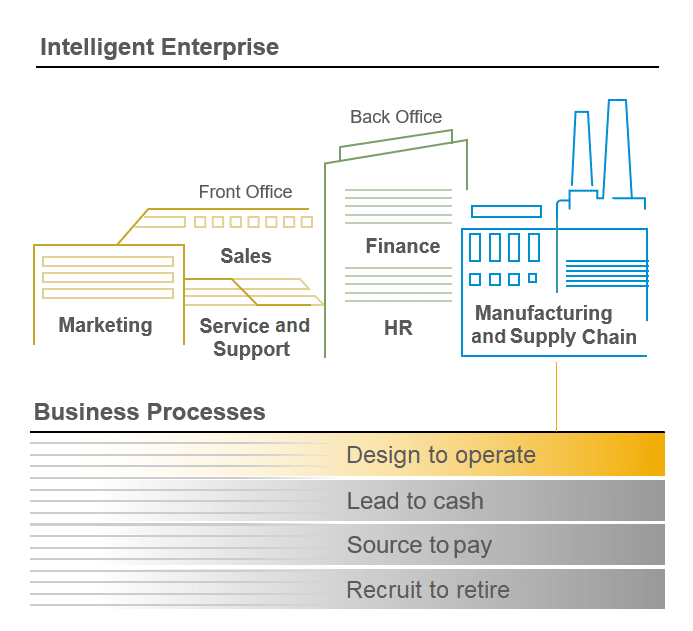Business environments are changing faster than ever before; customers that want to stay relevant and succeed need to adapt in ways that, quite frankly, none of us imagined 18 months ago.
The economic situation is forcing us all to think outside the box, define new business models and new processes, and accelerate innovation and digital transformation so we can operate in a much more dynamic and agile fashion.
Intelligent Enterprises Need to Be Integrated Enterprises
In response to the business requirements for increased agility, savvy organizations are bringing on more and more solutions and innovation at a pace that’s faster than any time in their histories. And why is that? Because intelligent enterprises put innovation and technology to work in as many parts and processes of their businesses as possible. And intelligent enterprises know that business agility requires that all those parts and processes work together. They need to be integrated.
Together, SAP and our partners — including global service partners as well as implementation, reseller, and software partners — are bringing this innovation, technology, and integration to businesses around the world. This article examines what our customers are facing as they look forward, and explores how providing connected business technology and improving our partner experience can help us better deliver on customer needs.
Customers Struggle with Cloud Complexity
As organizations shift to the cloud, decisionmaking has become more decentralized and individual lines of business are able to deploy point solutions without IT oversight, which creates silos of data that span fragmented business process flows. The statistics below emphasize the risks, pace, and volume of challenges that organizations face today:
- Large enterprises are already using more than 200 software-as-a-service (SaaS) applications
- The unique number of SaaS applications in use per company is up approximately 30% year over year
- Duplicate subscriptions have increased by 80%
- Orphaned application subscriptions are up almost 100%
- Enterprise companies must manage an average of 21,580 people-to-application connections
- Sixty percent of the SaaS stack is changing every two years
All of this has also led to increase security risks and costs:
- Twenty-seven percent of cloud computing budget is wasted due to poor management
- Nearly two-thirds of organizations see security as the biggest challenge for cloud adoption
- Security breaches are on the increase; the FBI reported that cyberattack complaints in the first quarter of 2020 were up 400% compared to the previous quarter
In fact, 52% of enterprises say that the goal of making operational enhancements and modernizing their IT systems was to improve information flow. So it is no wonder that IT is overtaxed and searching for a way to help ensure systems and data remain holistic, secure, and connected.
Business Process Extension and Integration Is Critical
Managing data has always been a critical part of our collaboration with customers. Over time, as the SAP portfolio has grown, the data our solutions manage has also increased. Today, 77% of the world’s transactions touch an SAP solution.
That’s a fact that is both humbling and inspiring. It also highlights the opportunity we have with our partners to bring more value to all the different processes and functions within our customers’ businesses.
Because of that reach, a partner building on, integrating with, or extending an SAP platform, has the opportunity to help customers by developing solutions that span hybrid landscapes, connecting lines of business and tapping into data domains from finance, assets, and products to customers, vendors, employees, and more.
Let’s take a closer look at how this works and why this is important.
As described, a critical aspect of the Intelligent Enterprise is the connected nature of its business processes. The more connected and intelligent these processes are, the more responsive, resilient, and efficient an organization can be. SAP has mapped several business processes that reach across traditional domains and system silos to cover the key needs of most companies. These include design to operate, lead to cash, source to pay, and recruit to retire.

These business processes can each be broken down further into specific components or sub-processes.
Looking at the design-to-operate business process – and specifically the supplier management sub-process – there is an opportunity to tap into multiple master data sets to turn data into business value for customers. For example, within supplier management, we have identified four solutions for the SAP offerings:
- Supplier info
- Supplier life cycle
- Supplier performance
- Risk management
Each of these solutions touch various master data domains such as employees, finance, assets, and products – enriching the business process and ultimately increasing the value and impact that each sub-process brings to an organization. Partner extensions, integrations, and applications are essential in driving this value, as they expand SAP offerings and answer unique and critical customer requirements. Today, within the design-to-operate business process, partners are adding value with solutions that extend the core SAP offering, including supplier certification, sustainability ratings, and search and data lookup.
Solutions in these areas can also benefit from tapping into multiple data sources — across cloud, on premise, and hybrid landscapes — providing a holistic supplier view and extending the value they deliver through the design-to-operate business process.
Multiplying that value across all processes and sub-processes shows that the potential for partners and customers is virtually limitless.
Eliminating Complexity
By working even closer with partners, and with commitment to a unified technology platform, SAP can equip our customers to connect their data and business processes to win this battle over fragmentation. We can help customers overcome many of the challenges they face. We can also bring much-needed relief to IT teams, strengthening the value of what we offer while earning the loyalty and trust of our customers.
To achieve this, SAP launched a unifying technology foundation: SAP Business Technology Platform. The platform includes capabilities and services that connect data, applications, processes, people, and devices. Two central elements of the platform’s capabilities are SAP Integration Suite and SAP Extension Suite, which simplify application integration and extension development, helping partners realize faster time to value with lower development risks.
SAP Business Technology Platform is supported with a simplified partner experience, demonstrating an increased commitment to partners, which grows as dedication to SAP technology grows, so that SAP and partners can more effectively chart a new path forward together. SAP partners can learn more here.
These two topics are important goals and will be the focus of a follow-up article — stay tuned. In the meantime, explore SAP’s software partner program at SAP.com/BuildBetter.com.
Jagdish Sahasrabudhe is CTO of the Global Partner Organization at SAP.



